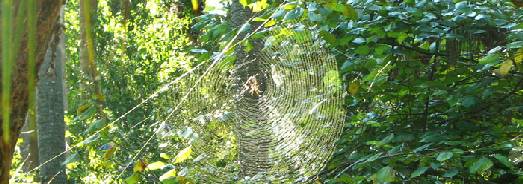
Jurassic Spider: What's in a Name? by Brian Thomas, M.S. *

A massive fossilized spider has set a new size record. It looks like today's golden orb-weavers, which are large enough to dine on small birds. This discovery, in conjunction with similar ones, presents problems for evolutionary origins, and also shows how a name choice can be misleading. What did scientists decide to name this fossil, and why?
The fossil was found in Daohugou rock beds in China, along with amphibians, dinosaurs, many insects including flies and mayflies, and a large semiaquatic mammal.1 The giant web-weaving spider was identifiable down to the genus name, and an international team of researchers described it in the journal Biology Letters.2
Known to inhabit mostly tropical areas today, the golden orb-weaver spiders that look closest to the fossil find are in the genus Nephila, which has over 35 named species.3 A popular 2008 email circulation showed a photograph of one in Australia, devouring a bird that was caught in its giant web.4
Was the fossil Nephila different enough to justify being given a new name? Considering that species names are routinely given to animals in the same genus based merely on such things as slight color or texture variations, or even just where they live, it is not surprising that this fossil spider received a unique label—Nephila jurassica. But tying the fossil's name to a specific geologic time period only reinforces evolutionary assumptions regarding its age.
Based on how the nearby dinosaur fossils correspond to geologic charts with evolutionary age assignments printed on them, these authors asserted that N. jurassica lived approximately 165 million years ago, which extends the fossil record "of the genus Nephila by approximately 130 Ma [million years]."2 What has "natural selection" accomplished with supposedly 130 million years of accumulated mutations in these spiders? One of the only differences between N. jurassica and its living relatives is that its abdomen is not as narrow.
But considering how fast other plants and animals are able to express differently-sized features in their descendants, it is a reasonable assumption that a narrower abdomen could be expressed in a single generation from parents with a wider abdomen.5,6,7 The close resemblance of this fossil to its living relatives is a consistent theme with fossil finds, including a recently discovered spider in the same area of China that was dated as 165 million years old but was described as a "dead ringer" to its modern counterpart.8
Spiders are not typically fossilized today. Other fossils found with N. jurassica include wet-climate gymnosperm plants, which do not routinely fossilize either. Their very presence together, having been transported and buried in fine sediments carried by water, implicates a unique flooding event.
A strong candidate for such an event is the great worldwide Flood of Noah's day. Sandy, muddy, fast-moving waters, accompanied by ash from volcanic eruptions (as would be expected from the events described in Genesis 7:11), would have the requisite energy to quickly transport the menagerie of creatures from their pre-Flood semiaquatic environment and deposit them in what became the Daohugou rock beds.
The species name jurassica serves to reinforce the evolutionary idea that this spider lived in some long-gone Jurassic era. But the Flood was only thousands of years ago, so it is not surprising to find that today's Nephila spiders look almost the same as those deposited during the great Flood. Since Nephila spiders are alive today, it is misleading to refer to this one as a "Jurassic" creature. They are modern creatures!
References
* Mr. Thomas is Science Writer at the Institute for Creation Research.
http://www.icr.org/article/jurassic-spider-whats-name/